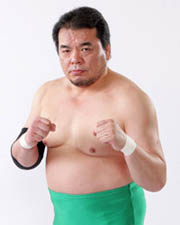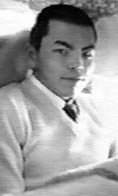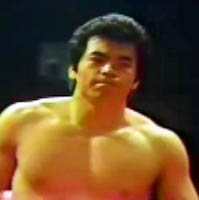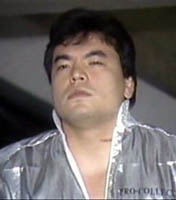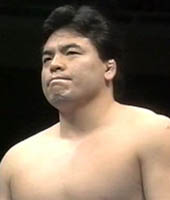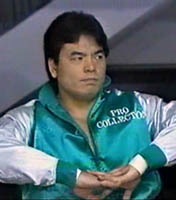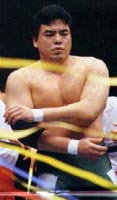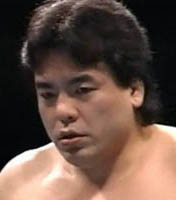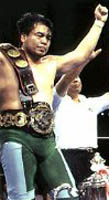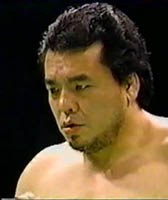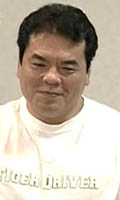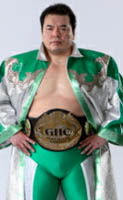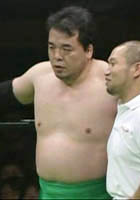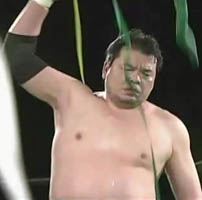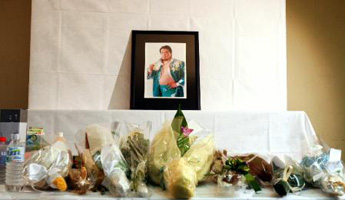
|
||||||||||||||||||||||||||||||
|---|---|---|---|---|---|---|---|---|---|---|---|---|---|---|---|---|---|---|---|---|---|---|---|---|---|---|---|---|---|---|
|
Mitsuharu Misawa
Birthdate: June 18th, 1962 Championship History: GHC Heavyweight Championship (Held Three Times): GHC Tag Team Championship with Yoshinari Ogawa (Held Two Times): Triple Crown Championship (Held Five Times): All Japan World Tag Team Championship with Toshiaki Kawada (Held Two Times): All Japan World Tag Team Championship with Kenta Kobashi (Held Two Times): All Japan World Tag Team Championship with Jun Akiyama: All Japan World Tag Team Championship with Yoshinari Ogawa: All Asia Tag Team Championship with Kenta Kobashi: All Asia Tag Team Championship with Yoshinari Ogawa: PWF Tag Team Championship with Jumbo Tsuruta: NWA International Jr. Heavyweight Championship: Tokyo Sports Newspaper Awards: Biggest Matches: Matches Reviewed: Mitsuharu Misawa Through the Years:
Pictures: Featured Signature Moves Video Collection Other Signature Moves: Move Debut Date: Career History: One of the greatest wrestlers in history, Mitsuharu Misawa died young but over a 28 year career he set the bar so high that it may never be reached. Just to demonstrate his nearly flawless ability in the ring, from 1985 to 2003 Misawa had 24 Five Star Matches given by Dave Meltzer's Wrestling Observer, an average of over one a year. For comparison sake, Ric Flair, Bret Hart, Chris Benoit, Keiji Mutoh, Shinya Hashimoto, Antonio Inoki, and Jushin Thunder Liger only had 13.... combined. He main evented at the Budokan over 55 times in his career (including at one point 11 in a row from June 1992 to March 1994) and twice main evented at the Tokyo Dome. Beyond being a great wrestler he also showed he was a great promoter as in 2000 he left to create Pro Wrestling NOAH, taking most of the All Japan roster with him. At one point in Japan, particularly in 2004 and 2005, NOAH was the top drawing wrestling promotion in Japan with Misawa and Kobashi on top. From 1990 onward Misawa never missed significant time due to injuries, and once he formed NOAH in 2000 he wrestled on every single tour that NOAH had up until his death in June of 2009, the only wrestler to have such an impressive attendance record. As great and dedicated as Misawa was, however, his style sadly took its toll on his body which helped lead to his death in the wrestling ring after taking one too many hard drops. A tragic end to a magnificent career, Misawa will always be remembered not only for his superior wrestling ability but also for the final price that he paid for his destructive wrestling style in the ring and his stubbornness out of it. Mitsuharu Misawa was born on June 18th, 1962 in Koshiyaga, Saitama, Japan. An amateur wrestler in high school, in 1980 he began training for professional wrestling. Misawa debuted on August 21st, 1981 against Shiro Koshinaka and over the next several years he began honing his craft as he got the opportunity to train with some of the top wrestlers in the world in Giant Baba, Dory Funk Jr., Jumbo Tsuruta, and The Destroyer. In 1982, his first full year as a wrestler, Misawa won the Tokyo Sports Newspaper Rookie of the Year. By 1983 he had developed enough to have competitive matches against the upper tier of Jr. Heavyweights, including Shiro Koshinaka and Dynamite Kid. In 1984, Misawa and Koshinaka went to wrestle for EMLL in Mexico, forming a heel tag team as "Kamikaze Misawa" and "Samurai Shiro." In the summer, an interesting development occurred that started in New Japan but carried over to have a serious impact on Misawa's career. In 1981 Satoru Sayama had become Tiger Mask, and as Tiger Mask he became one of the most exciting Jr. Heavyweights in the world and arguably one of the first Jr. Heavyweight draws in puroresu history. But in 1983 he decided to stop wrestling as Tiger Mask and left New Japan altogether, leaving the gimmick dormant. New Japan did not own the rights to Tiger Mask but had been paying for the right to use the Tiger Mask character from Ikki Kajiwara, the author of the popular Tiger Mask TV show and manga, and since Sayama had retired they did not retain the rights to use it. With wrestling fans still remembering Tiger Mask as one of the top Jr. Heavyweights in Japan, Giant Baba quickly brought the rights to use the gimmick from Kajiwara. All Japan had a limited number of young Jr. Heavyweights at the time that would fit into the mystique as Tiger Mask, and Misawa was chosen to done the mask which instantly made him a star (rumor has it that Koshinaka wanted the role, and when he didn't get it he left for New Japan). As Tiger Mask, Misawa entered the next phase of his career that would see him continue to climb up the ladder in All Japan. On August 26th, 1984, Mitsuharu Misawa wrestled his first match as Tiger Mask against La Fiera, his trainer in Mexico. Tiger Mask would win the match, and even though Misawa lacked the flash of Sayama he was a good enough wrestler that he was accepted in the role by the fans. Now the star of the Jr. Heavyweight division, All Japan brought many of the original Tiger Mask's old foes from New Japan into the promotion to resume the feuds that the crowd recognized. This included Misawa battling Dynamite Kid, the original Black Tiger, and Kuniaki Kobayashi. On June 21st, 1985, Misawa got his first shot at the NWA International Junior Heavyweight Championship when he faced off against Kobayashi, and even though Misawa came up short it was still a very memorable night for him as it was his first time wrestling at the Budokan. Misawa would avenge his loss a few months later when on August 31st, 1985 at Sumo Hall he defeated Kobayashi to win the NWA International Junior Heavyweight Championship, his first title. For the rest of the year Misawa continued gaining popularity and he defended the title up to June of 1986, when the decision was made for Misawa to graduate to the heavyweight division. The decision to move Misawa to the heavyweight division was a debated one. The issue wasn't whether or not Misawa was ready, as he was, and in Japan it is not uncommon for a wrestler to be a Jr. Heavyweight to start his career before moving on to the heavyweight division. The part people questioned was keeping Misawa as Tiger Mask, as for the five years prior Tiger Mask had always been a high flying exciting Jr. Heavyweight. Now fans had to adjust to having a wrestler wearing the mask that wrestled like a heavyweight, which partly negated the gimmick. Nonetheless Misawa began wrestling with the heavyweights, facing such stars as Riki Choshu and Great Kabuki. On July 3rd, 1987, Misawa teamed with Jumbo Tsuruta to win the PWF Tag Team Championship, his first title as a heavyweight. They would hold the belts though for only eight days as they dropped the titles back to Ted DiBiase and Stan Hansen. By 1988, Misawa was solidly in the semi-main event role and even though he clearly wasn't ready for the top title he had proven that he was on his way up. On March 8th, 1989 he had his biggest match to date as he faced Ricky Steamboat for the NWA World Heavyweight Championship, a match that Misawa lost but showed how far he had come. On March 6th, 1990, Misawa faced off against Kenta Kobashi for the first time on tape, and he defeated the wrestler that would give him so much hell over the next 15 years of their respective careers. By the spring of 1990, Misawa was beginning to outgrow the Tiger Mask gimmick and a decision was made for Misawa to enter the next phase of his career. On May 14th, 1990, Misawa teamed with his friend Toshiaki Kawada to face off against Yoshiaki Yatsu and Hiromichi Fuyuki. What seemed at first to be a normal match turned out to be anything but that, as halfway through the match Misawa asked Kawada to help him take off his mask. Kawada did, and Misawa snapped as he fought his opponents around the ring as the crowd chanted "MISAWA! MISAWA!". Misawa immediately moved into a feud that would set the tone over the next few years, as Tsuruta and Misawa began meeting more in tag matches leading up to June. On June 8th, 1990, the young Mitsuharu Misawa faced off against Jumbo Tsuruta in his first main event at the Budokan. No one gave Misawa a chance at beating the former Triple Crown Champion who was still in top form, but to the shock of everyone Misawa pinned Tsuruta and was paraded around the ring as the crowd chanted his name. In just a few months Misawa had gone from a solid semi-main eventer to a legitimate main event wrestler, and even though he still was years away from winning the Triple Crown no one would again doubt his ability to pull out a win against any opponent. During the next few years Misawa focused on both singles and tag team action, excelling in both. He got an almost immediate chance to win the Triple Crown based off his win over Tsuruta, but in July Stan Hansen defeated Misawa for the vacant title. Having more luck at the time in the tag team division, Misawa teamed with Kawada and won the All Japan World Tag Team Championship for the first time on July 24th, 1991. That next year he would also win the Real World Tag League for the first time (also with Kawada), cementing himself as one of the premiere tag team wrestlers. Jumbo Tsuruta would get his revenge on Misawa on April 18th, 1991 when Misawa challenged for the Triple Crown, as Tsuruta pinned Misawa after a backdrop suplex. After another failed challenge in March of 1992, Misawa got a rematch against the great gaijin Stan Hansen on August 22nd, 1992 at the Budokan. This time, Misawa would down the Fuchinkan with the Running Elbow Smash. After winning the Real World Tag League in December of 1992 (and thus winning the All Japan World Tag Team Championship), as 1992 ended Misawa had five belts around his waist. The era of Mitsuharu Misawa had begun. From 1992 to 1995, Misawa had one of the most successful stretches that any wrestler has ever had. The accomplishment is even more incredible when considering his competition was among the best wrestlers in the world. Besides main eventing 11 consecutive Budokan shows, Misawa won the Real World Tag League in 1993, 1994, and 1995. The last two times were with Kenta Kobashi, and the pair would be the only ones to hold the title from December of 1993 until June of 1995. While dominating the tag team division, Misawa was having similar luck in the singles division. After winning the Triple Crown in August of 1992, Misawa would hold the title for a record 705 days. During that time he defeated the best that All Japan had to offer, including Toshiaki Kawada (three times), Stan Hansen (twice), Akira Taue, and Dr. Death Steve Williams. Misawa was not only dominating, but he also was putting on what are considered by many some of the best matches in wrestling history. From 1992 to 1995, Misawa had 11 Five Star Matches as given by the Wrestling Observer and won Tag Team Wrestler of the Year in 1993 and 1994 from the Tokyo Sports Newsletter. On June 3rd, 1994 Misawa defended the Triple Crown against Toshiaki Kawada in what was voted the #1 All Japan wrestling match of the 1990s in the DVDVR Best of the 1990s poll. Even though Misawa would lose the Triple Crown to Steve Williams in July of 1994, he would win the title back the following spring and hold the Triple Crown for another year. In 1995, Misawa won the Champion Carnival, the Real World Tag League, the Triple Crown, held the All Japan World Tag Team Championship, and won the Tokyo Sports Newsletter Match of the Year. Truly one of the greatest single performance periods in wrestling history, Misawa had great support around him but rose above to be the leader among great men. As 1996 rolled in, Misawa never stopped winning as he continued to be one of the dominate wrestlers in All Japan. But the competition was only getting tougher as Kobashi and Taue were entering their prime, Kawada and Hansen were still dangerous, and Akiyama was growing into a very talented wrestler. Misawa lost the Triple Crown on May 24th, 1996 to Akira Taue but the day before he had teamed with Akiyama to win the All Japan World Tag Team Championship for the 5th time to ensure he still had gold around his waist. They would lose the titles in September, and afterwards Misawa took a break from the tag team division as he only had three challenges for the All Japan World Tag Team Championship in the next three years. Back in singles action, Misawa won the Triple Crown for the 3rd time on January 20th, 1997 against Kenta Kobashi. In the Champion Carnival that year, still the Triple Crown Champion, Misawa lost to Kawada in a singles match for the first time on a televised event. Up to this point Kawada had four times challenged Misawa for the Triple Crown, with Misawa winning every time (Kawada did win the Triple Crown in 1994, but he didn't defeat Misawa to win it). The Champion Carnival win was a bit tainted (Misawa had already wrestled a 30 minute draw against Kobashi that same night while it was Kawada's first match), but many felt it would give Kawada the confidence he needed to finally beat Misawa. Kawada got his chance on June 6th as he challenged Misawa for the fifth time for the Triple Crown, but Misawa won with a German Suplex Hold. All this led up to the Tokyo Dome on May 1st, 1998, as Misawa was still the champion and Kawada was ready to try once again to beat his old friend and foe for the ultimate prize in All Japan. Leading up to the Tokyo Dome, Misawa cemented that he was the best in All Japan when he won the Champion Carnival for the 2nd time, defeating Jun Akiyama in the Finals (Misawa and Kawada went to a draw in their match). All Japan as a promotion entered the Tokyo Dome for the first time on May 1st, 1998, as Kawada took one more shot at Misawa for the Triple Crown. This time, Kawada would finally defeat his long time nemesis and win the Triple Crown for the 2nd time in his career. His happiness would be short lived however as the next month he lost the title to Kenta Kobashi. On October 31st, 1998 Misawa challenged Kobashi for the Triple Crown and for the 4th time left with three titles around his waist. Misawa met Kawada again in January of 1999, and this time Kawada debuted the devastating Ganso Bomb to defeat Misawa for the second time in a year for the Triple Crown. Unfortunately for Kawada he would break his arm in the match and the next week vacated the title. Vader, returning to Japan after a stint in the WWF, beat Taue in a decision match for the Triple Crown, setting up a match against Misawa at the Tokyo Dome. On May 2nd, 1999 Misawa main evented the Tokyo Dome again, this time as the challenger, and he defeated the giant gaijin to win the Triple Crown for an record fifth time (a record that he now shares fittingly with Toshiaki Kawada). Misawa lost the Triple Crown back to Vader in October after successfully defending it against Kobashi and Kawada, and Misawa would never challenge for the Triple Crown again. Back in January of 1999, the owner of All Japan Giant Baba died at the age of 61. His wife Motoko Baba took over and soon was at odds with Misawa on a number of issues, some of which included pay increases (it was rumored at the time that Misawa made about the same amount of money as New Japan's Jr. Heavyweights) and health insurance. Motoko wouldn't budge and in May of 2000, Misawa was removed as President of All Japan, a position he had held since Giant Baba's death. This seemed to be the last straw, as soon thereafter Misawa announced that he was leaving All Japan. But he wasn't leaving without a plan, as the vast majority of All Japan's native wrestlers went with him (only Fuchi and Kawada stayed in All Japan) and he also took All Japan's television deal. Misawa held a press conference on June 15th, 2000 in which he announced his new promotion would have its first event in August. Regarding his feud with Kawada and the fact that Kawada was not leaving All Japan, Misawa said that "[Kawada and I] have been together since we were children. We have been through a lot together. He has made his decision, so I want him to do his best to the end." The next day he announced that his new promotion would be called Pro Wrestling NOAH, and the next (and final) phase of Misawa's career was set to begin. Misawa wrestled his last match in All Japan on July 20th, 2000, and as soon as his match ended he left the arena, only to return to All Japan for a wrestling match twice in the next nine years. When Misawa created NOAH, originally the plan was to have the younger Akiyama and Kobashi be the leaders of the promotion with Misawa taking on more the role of Tsuruta in 1991 and 1992, that being a main eventer but not the focus of the promotion anymore. Misawa was 38 years old when NOAH had its first card, but he looked older than that as he had participated in a very demanding schedule the last 10 years. As the long commentary and list of accomplishments above illustrates Misawa did not have many days off, and since he was in the main event he was frequently wrestling in matches that went over 30 minutes. On top of that, starting in around 1997 the style of All Japan changed to a focus on "head drop" moves. They had always existed, such as William's Backdrop Driver or Misawa's Tiger Driver '91, but in the late 90s the craze really took over the promotion as not only did every main wrestler have moves that landed their opponent on their upper shoulders, neck, and head but the wrestlers were kicking out of the moves. This made the crowd not react to them as loudly, so the wrestlers had to step it up and do even more head drop moves and even more dangerous moves. It was a vicious cycle that came to NOAH when Misawa and company left, and it didn't finally start slowing down until around 2006. These types of moves were generally restricted to the main event, but that is where Misawa always was. After taking dozens of German suplexes, powerbombs, backdrop suplexes, exploders, and burning hammers over several years Misawa was not in great physical shape. But he didn't have any serious injuries, no broken bones or surgeries, so he kept plugging along as a little medication and toughness can overcome a sore shoulder or a banged up knee. NOAH was supposed to help him ease into a lesser role, but unfortunately the opposite happened and Misawa never got the break that he needed to rest his aching body. To illustrate that point, on August 5th and August 6th NOAH had their first two events at Tokyo Differ Ariake. On the first show the main event saw Kenta Kobashi and Jun Akiyama vs. Mitsuharu Misawa and Akira Taue with a two out of three falls match, with Kobashi/Akiyama winning in two falls as Akiyama forced Misawa to submit and then pinned Taue after an exploder. On August 6th, the main event saw Akiyama defeat Kobashi in a 25 minute singles match, with Misawa playing support in a semi-main event tag match. NOAH had their first big event on December 23rd at Tokyo Ariake Colosseum in front of over 12,000 fans, and in the main event Kobashi avenged his earlier loss when he defeated Akiyama after a Burning Hammer. This set up the promotion to feature Kobashi and Akiyama as was originally planned, as now they were 1-1 against each other. But things weren't going perfect, as in January of 2001 Kobashi was forced to take time off for his injured knees. He would end up missing the next 13 months. In the spring a tournament was held to crown the first Global Honor Crown Heavyweight Championship, and on March 15th, 2001 Misawa defeated Takayama in the Finals to win the title. Misawa only made one successful defense before losing the title to Jun Akiyama on July 27th, 2001. Misawa also wrestled in the tournament to crown the first GHC Tag Team Champions, but Misawa and his partner Ogawa lost in the semi-finals to Jun Akiyama and Akitoshi Saito. Later in 2001, Misawa teamed with Ogawa again to challenge for the GHC Tag Team Championship, and on November 30th, 2001 they defeated Vader and Scorpio to win the titles. They held them for only a few weeks however before dropping the titles to Takao Omori and Yoshihiro Takayama. In 2002, Misawa had a brief feud with Kodo Fuyuki with culminated to a singles match on April 7th, 2002 at Tokyo Ariake Colosseum with Misawa winning after a running elbow smash, but not before perhaps going through the first table in his career. For the first time in his career, Misawa also went to New Japan on May 2nd, 2002 to take on Masahiro Chono, but the match ended in a draw. On September 23rd, 2002 Misawa challenged Yoshihiro Takayama for the GHC Heavyweight Championship, and won the title for the 2nd time. He held the title until March 1st, 2003 when Kenta Kobashi was finally healthy enough to lead the promotion. Kobashi won the title that night in an epic battle and would hold the title for two years. Misawa did not challenge for the belt in that stretch and instead feuded with Shiro Koshinaka in the fall, with Misawa defeating Koshinaka on December 6th, 2003 when he debuted the vertical drop Emerald Frosion. 2004 saw a few "firsts" for Misawa, who at the age of 41 was still able and willing to do new things. Before getting adventuresome, first he teamed with Ogawa to win the GHC Heavyweight Tag Team Championship for the second time on January 10th, defeating Yuji Nagata and Hiroshi Tanahashi. As he prepared for the first Tokyo Dome event for NOAH on July 10th, Misawa knew he had to do something special so he made a match that people had been dying to see - he invited Keiji Mutoh to the Tokyo Dome! Misawa teamed with Ogawa to take on Mutoh and Kea, and they had a classic encounter, including Misawa doing a Shining Wizard and Mutoh delivering a Emerald Frosion. Just over a week later, for the first time in four years Misawa went back to All Japan, defeating Satoshi Kojima after planting him with a Tiger Driver '91. Misawa wasn't done yet however, as he returned to All Japan on 10/31/04 to team with Mutoh, and they defeated the team of Hiroshi Hase and Kensuke Sasaki. As the year ended, Misawa and Ogawa were still the GHC Heavyweight Tag Team Champions, with seven successful defenses throughout the year. Misawa and Ogawa lost the GHC Heavyweight Tag Team Championship on January 23rd, 2005 to Doug Williams and Scorpio, and it would be the last time that Misawa would hold the tag title (Misawa only challenged for the tag title one more time in his career, which was the night that he passed away). 2005 also saw Genichiro Tenryu invade the promotion and generally got under the skin of the NOAH wrestlers. After facing off against Kobashi in tag matches and defeating Ogawa in a singles match, Tenryu got Misawa on November 5th. Misawa got revenge for the carnage that Tenryu had spread by leveling him with an elbow smash for the pinfall victory. In July, NOAH held their second Tokyo Dome show. Needing to up the ante from the year before, Misawa faced off against his old friend and enemy Toshiaki Kawada! For the first time since the split the two old rivals faced off in the main event. Both wrestlers pulled out all the stops, but once again Misawa defeated his old foe after an elbow smash. Also in 2005, Misawa made another New Japan appearance on May 14th when he teamed with Tatsumi Fujinami to defeat Masahiro Chono and Jushin Thunder Liger. On September 18th, 2005 Misawa had his first challenge of the GHC Heavyweight Championship since losing it in early 2003 as he faced off with Takeshi Rikio, but the young Rikio proved to be too much as he beat the aging owner with the Muso. By 2006, things in NOAH weren't going quite as Misawa had drawn them up, as the young stars were having trouble catching on, Akiyama never became the ace, and Kobashi would be diagnosed with cancer in June of 2006 which would take him out of action for a year and a half. For the first time NOAH was having trouble filling the Budokan and things were almost in panic mode. In March, in an attempt to help the young stars get over with the crowd a new generation vs. old guard series was done with Misawa facing off against Morishima. The plan seemed to work, as even though Misawa defeated Morishima it was perhaps the best match of Morishima's career and the crowd was extremely vocal during the match. Akiyama won the GHC Heavyweight Champion in 2006 but once again was defeated by a Jr. Heavyweight, Naomichi Marufuji, in September. After a poor draw at the Budokan for an October Marufuji title defense against KENTA (many questioned the decision to have two Jr. Heavyweights main event the Budokan with no big matches or title matches underneath), Misawa made himself Marufuji's next title defense and on December 10th, 2006 Misawa won the GHC Heavyweight Championship for the 3rd time. 2007 did not start off well for Misawa, as in his first title defense against Morishima he took a powerbomb on the floor which clearly knocked him for a loop. Morishima was worried and thus wasn't hitting as hard the rest of the match, making him look weak as Misawa picked up the victory. While it seemed apparent that Misawa needed some time off to deal with what was diagnosed as a concussion and cervical sprain, Misawa didn't miss the next tour. It has been theorized that this was the beginning of Misawa's bigger health issues as his condition quickly deteriorated over the next year as the Misawa that faced Morishima in March of 2006 was long gone by the summer of 2007. But Misawa held onto the belt since he had no one to give it to, and over the next year he defeated Sano, Bison Smith, Akira Taue, Marufuji, Samoa Joe, and KENTA in title defenses. The only positive of 2007 was the return of Kobashi in December, where Misawa pinned him in a tag team match after hitting an Avalanche Emerald Frosion. Clearly not in top condition, Misawa finally lost the title to Morishima on March 2nd, 2008, almost exactly two years after Morishima had almost defeated Misawa in the match that helped boost Morishima to the main event scene. The next tour after losing the title contained the Global Tag League, where Misawa teamed with Ogawa. The pair did quite well and had the chance to win, but Akitoshi Saito and Bison Smith defeated them on the last day to take the tournament victory. The rest of 2008 was uneventful for Misawa, as he mostly was towards the middle to upper-middle of the cards wrestling in tag team matches. He finally appeared to be in the role he wanted as he reached the age of 45, but he still wasn't taking time off as just his name appearing on the card helped the attendances. In June, Misawa traveled to England and teamed with Naomichi Marufuji to defeat Kenta Kobashi and Go Shiozaki, much to the delight of those that live in England that watch puroresu. During the last tour of the year a short six man tag tournament was held, with Misawa's team (with Takeshi Morishima and Mohammed Yone) defeating Jun Akiyama, Takeshi Rikio, and Takashi Sugiura in the Finals to win the tournament. As 2009 began, things were looking up a bit for NOAH in terms of the in-ring product, with Go Shiozaki catching on with the crowd, along with the group of Rikio, Morishima, and Marufuji hanging in there and slowly winning over the crowd. But the news wasn't all good, as their primary TV carrier did not renew their television show. NOAH still was on TV of course but they lose their best time slot and were reduced to a station that was less popular in Japan. This helped lead to NOAH taking some chances, with Shiozaki defeating some bigger names to get him up the card faster and with groups forming heel and face factions for the first time since SUWA retired. Misawa started the year wrestling in New Japan at the Tokyo Dome, and for the first time in awhile Misawa really seemed to put in extra effort, giving a solid performance to help make the match one of the best of the night. In the Global Tag League, Misawa teamed with the emerging Shiozaki and together they would win the tournament, defeating Kensuke Sasaki and Takeshi Morishima in the finals (Go pinned Morishima). In fact, in every match they won it was Shiozaki that picked up the pinfall. This set them up for a chance at the GHC Heavyweight Tag Team Championship, which at the time was held by Akitoshi Saito and Bison Smith. The match took place on June 13th, 2009, with Misawa and Shiozaki being the favorites as it would give Shiozaki his first major championship to help his elevation to main event status. For the upcoming section, I am including video and pictures related to Misawa's death. They are only through links however, nothing is shown on this page itself. I apologize if this offends anyone, but for some people it helps bring closure to understand exactly what happened. If you see the text highlight in black it contains a link to a video or picture about what the text mentions, so if such images and videos will offend you then I implore you to just keep reading and not to click on it. As we all know by now, that match on June 13th would be the last match of Mitsuharu Misawa's career. The footage of the match itself was never released, but from pictures, videos, and fan accounts a pretty good picture was painted as to what happened. First, I want to emphasize that the exact cause of death is at least partly speculative. The family requested that the autopsy not be released, which it wasn't, but one of the local policemen had started that the cause of death was from a Cervical Spinal Cord Injury. Based off the pictures and fan accounts that would have been the best assumption anyway and since it came from an official everyone is going with that as the official cause of death. During the match itself, live reports said that Misawa was moving slow, looked out of it, and wasn't himself prior to the backdrop suplex by Saito. When he took the move, all accounts reported that Misawa didn't take the move right and wasn't "loose," but rather took the move hard on the back of his neck. For the last year, Misawa has had problems with his neck and was seen rubbing it at times, but he never had a full check-up or took any time off, the latter because he was afraid the promotion would go under without him. After taking the move, reportedly the referee asked Misawa if he was ok, he said "no," and then lost consciousness. A doctor came into the ring and gave Misawa CPR while the ring filled with wrestlers who wanted to help, but couldn't. The crowd chanted for Misawa while the wrestlers watched helplessly, but after several moments it became clear that he wasn't getting up. They worked on him in the ring for a few minutes until the ambulance arrived (he never regained consciousness), then the doctors tried for a minute to revive him before putting him on the stretcher to take him to the hospital. He was declared deceased when he was at the hospital, so officially he didn't die in the wrestling ring. Saito was devastated as one can imagine, even though it is very clear judging by his style and overall appearance over the last year prior to his death that something was already wrong and it was only a matter of time. Misawa was doing what he thought was right for the company in fighting through injuries, but unfortunately in the end it only led to a tragic results. There are a lot of What Ifs? that can be asked, most without answers, but the one clear fact is that Mitsuharu Misawa literally gave his life for wrestling and his promotion, along with all the employees of NOAH and the fans.
Misawa's legacy will be a dual one. He will always be remembered as one of the top wrestlers during one of the must financially successful periods in wrestling history. He held every major title in the promotions he wrestled in, won every award, and won all the different tournaments. He main evented more sold out shows than one could count and excelled in both tag team and singles matches. He started a successful wrestling promotion, a rare feat for a wrestler, and was an unselfish booker that only gave himself titles when he didn't see any other choice. By all accounts he was approachable and friendly, and I have never heard a negative word spoken about him outside the ring. His number of high level matches is astounding and he had the ability to elevate those around him to make them better as well. He was a hard worker, tough, and a master in the ring. His accomplishments and abilities won't be forgotten and no discussion of the best wrestlers ever is complete without his name being mentioned. His other legacy, sadly, will be questions surrounding his death. Misawa was one of the major participants in the 'head drop moves' era in All Japan and took more than even his fellow wrestlers did as he was constantly in the main event and had a lot of matches against Kobashi who had more regular head drop moves than Kawada and Misawa. The more head drop moves they did, the more fans wanted, and it kept getting worse and worse. Even in 2003, when he was 40, he and Kobashi did repeated head drop moves on their no doubt already damaged necks. The other part is concern that his death was preventable. What if he had been required to go to the doctor? What if he had taken a year off like Kobashi has? These are questions that can't be answered, although most are in agreement that if he had gotten a full checkup, perhaps the gravity of the situation would have reached him and he would have taken better care of himself. I wish, on a personal note, that we could separate the in-ring successes of Misawa from his death, but it isn't possible. Those in-ring successes are what helped lead to his death. That doesn't mean he wouldn't have been popular without head drop moves as he would have been, but two of his signature traits were his ability to take head drop moves and never taking a tour off for 20 years, and there is no way to disconnect them from each other. But we can remember both. Yes, he was one of the greatest wrestlers ever and yes he was a great business man that in four years created the most profitable promotion in Japan. But he made mistakes, and hopefully wrestlers and promoters can learn from his mistakes so they won't happen in the future. One of the greatest wrestlers and one of the most tragic ends in puroresu history, the life and death of Mitsuharu Misawa will never be forgotten. |
||||||||||||||||||||||||||||||
|
